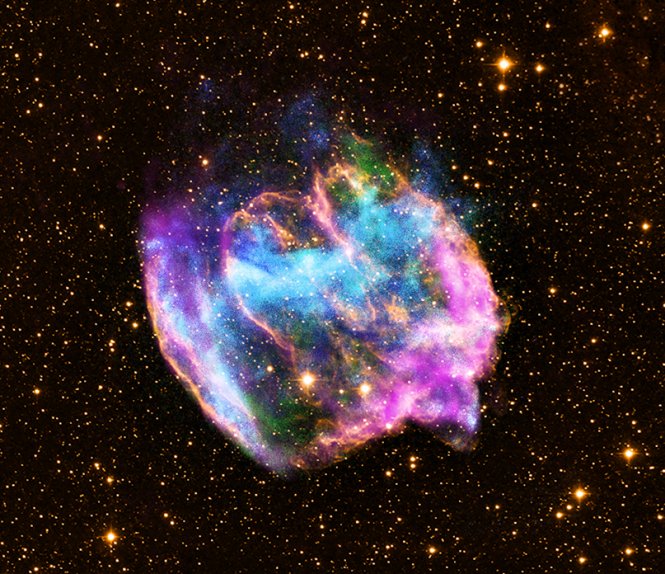
이 이미지에 표시된 매우 왜곡 된
초신성 잔해가 은하 (Milky Way galaxy)에 형성된
가장 최근의 블랙홀을 포함 할 수 있습니다.
The image combines X-rays from NASA's Chandra X-ray Observatory in blue and green, radio data from the NSF's Very Large Array in pink, and infrared data from Caltech's Palomar Observatory in yellow.
이미지는 NASA의 파란 찬드라 X-선 관측소, 녹색, 분홍색의 NSF의 매우 큰 배열에서 무선 데이터, 노란색의 칼 테크의 Palomar 천문대에서 적외선 데이터에서 X-선 조화를 이루고 있습니다.
The remnant, called W49B, is about a thousand years old, as seen from Earth, and is at a distance about 26,000 light years away.
W49B라고 잔여은, 같은 지구에서 볼 때, 천 년 정도이며, 거리 26,000 광년에 대한 거리에 있습니다.
The supernova explosions that destroy massive stars are generally symmetrical, with the stellar material blasting away more or less evenly in all directions.
거대한 별을 파괴 초신성의 폭발은 모든 방향으로 균일하게 더 많거나 적은을 멀리 날려 버리는 별의 물질로, 일반적으로 대칭입니다.
However, in the W49B supernova, material near the poles of the doomed rotating star was ejected at a much higher speed than material emanating from its equator.
그러나, W49B 초신성에, 운이 다한 회전 별 극 근처의 물질은 그 적도에서 나오는 자료보다 훨씬 더 높은 속도로 배출되었다.
Jets shooting away from the star's poles mainly shaped the supernova explosion and its aftermath.
별의 극에서 떨어져 촬영 분사는 주로 초신성 폭발과 사후 모양.
By tracing the distribution and amounts of different elements in the stellar debris field, researchers were able to compare the Chandra data to theoretical models of how a star explodes.
별의 파편 필드에 다른 요소의 분포와 양을 추적함으로써, 연구자 별이 폭발하는 방법에 이론적 모델에 찬드라 데이터를 비교할 수있었습니다.
For example, they found iron in only half of the remnant while other elements such as sulfur and silicon were spread throughout.
이러한 유황과 실리콘과 같은 다른 요소가 보급 된 예를 들어, 그들은 남은 만 반으로 철을 발견했다.
This matches predictions for an asymmetric explosion.
이 비대칭 폭발에 대한 예측과 일치합니다.
Also, W49B is much more barrel-shaped than most other remnants in X-rays and several other wavelengths, pointing to an unusual demise for this star.
또한, W49B 훨씬 더 배럴 모양의이 별에 특이한 붕괴로 연결되는 X-레이 및 기타 여러 파장의 다른 대부분의 유물보다 수 있습니다.
The authors also examined what sort of compact object the supernova explosion left behind.
저자는 또한 초신성의 폭발이 남긴 소형 객체의 어떤 종류 살펴 보았다.
Most of the time, massive stars that collapse into supernovas leave a dense spinning core called a neutron star.
시간의 대부분은, supernovas에 붕괴가 조밀 한 회전 중심을 두는 것이 거대한 별이 중성자 별을했다.
Astronomers can often detect these neutron stars through their X-ray or radio pulses, although sometimes an X-ray source is seen without pulsations.
때로는 X-선 소스 pulsations없이 볼 수있다하지만 천문학은 종종 자신의 X-선 또는 라디오 펄스을 통해 이러한 중성자 별을 발견 할 수 있습니다.
A careful search of the Chandra data revealed no evidence for a neutron star, implying an even more exotic object might have formed in the explosion, that is, a black hole.
찬드라 데이터의주의 검색 더 많은 이국적인 목적은, 블랙홀 즉, 폭발로 형성 될 암시, 중성자 별을 증거를 공개하지 않습니다.
This may be the youngest black hole formed in the Milky Way galaxy, with an age of only about a thousand years, as viewed from Earth (ie, not including the light travel time).
이 같은 지구에서 볼 수 천 년에 대한 전용의 나이가 은하 (Milky Way galaxy)에 형성된 젊은 블랙홀, (아닌 빛의 여행 시간을 포함 예) 될 수 있습니다.
A well-known example of a supernova remnant in our galaxy that likely contains a black hole is SS433.
가능성이 블랙홀을 포함 우리 은하계의 초신성 잔해의 잘 알려진 예는 SS433입니다.
This remnant is thought to have an age between 17,000 and 21,000 years, as seen from Earth, making it much older than W49B.
이 나머지는 W49B보다 훨씬 나이가 만드는 지구에서 볼로 17,000와 2만1천년 사이의 연령을 가지고 생각됩니다.
The new results on W49B, which were based on about two-and-a-half days of Chandra observing time, appear in a paper in the Feb. 10, 2013 issue of the Astrophysical Journal.
찬드라 관찰 시간의 2 반 일에 대한을 바탕으로 한 W49B에 새로운 결과는 2월 10일, Astrophysical 저널 2013 문제의 종이에 나타납니다.
The authors of the paper are Laura Lopez, from the Massachusetts Institute of Technology (MIT), Enrico Ramirez-Ruiz from the University of California at Santa Cruz, Daniel Castro, also of MIT, and Sarah Pearson from the University of Copenhagen in Denmark.
종이의 저자는 기술의 매사추세츠 공과 대학 (MIT), 또한 MIT의 산타 크루즈 (Santa Cruz), 다니엘 카스트로의 캘리포니아 대학에서 엔리코 라미레스 - 루이스, 덴마크의 코펜하겐 대학에서 사라 피어슨에서 로라 로페즈 있습니다.













